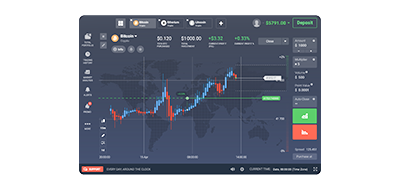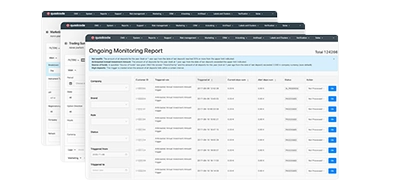Voltar
Contents
O que são níveis de retração de Fibonacci?

Demetris Makrides
Senior Business Development Manager

Vitaly Makarenko
Chief Commercial Officer
Os níveis de Fibonacci são um indicador de negociação popular que os traders utilizam para identificar possíveis níveis de suporte e resistência nos preços dos ativos. São representados graficamente como linhas horizontais em pontos de preço específicos. Essas linhas indicam as áreas previstas de suporte e resistência. Ao tentar prever a possível retração de um ativo após uma forte alta ou queda, os traders utilizam os níveis de Fibonacci de 23,6%, 38,2%, 50%, 61,8% e 100%.
Compreendendo os níveis de Fib
Os níveis de retração de Fibonacci são um dos vários tipos de análise que utilizam a sequência de Fibonacci, uma série matemática em que cada número é a soma dos dois números anteriores. Essa sequência inclui índices-chave que ajudam os traders a prever para onde os preços podem ir durante uma retração nos mercados natural e financeiro.
Quando o preço de um ativo apresenta oscilações, frequentemente não segue uma trajetória linear, assemelhando-se a uma subida direta, ou "mooning". Antes de retomar sua trajetória original, o preço frequentemente retorna a um determinado nível de preço que havia atingido anteriormente. Com o uso dos níveis de Fibonacci, um trader pode encontrar áreas de preço específicas onde as retrações podem ocorrer. Essas áreas de retração frequentemente servem como potenciais pontos de pausa ou reversão na tendência atual. A justificativa para essa estratégia baseia-se na compreensão das respostas típicas dos participantes do mercado aos níveis de preços e na utilização dos índices de Fibonacci para prever esses movimentos.
Esses níveis servem como zonas de suporte e resistência. Em uma tendência, eles podem indicar onde um recuo pode encontrar suporte antes de retomar sua subida. Por outro lado, em uma tendência de baixa, eles podem destacar onde uma recuperação pode encontrar resistência antes que o preço caia ainda mais. É crucial para os traders que desejam cronometrar suas entradas e saídas de forma eficaz compreender a função desses níveis e seu papel no contexto do mercado.
Usando níveis de Fib
Utilizar os níveis de retração de Fibonacci envolve identificar um movimento de preço, por exemplo, um pico seguido por uma queda seguida por outra subida. Para aplicar a ferramenta de Fibonacci, comece identificando os pontos mais baixos na ação do preço do ativo de seu interesse. Para um movimento de tendência de alta, vincule a oscilação de baixa à oscilação de alta; inversamente, para uma tendência de baixa, siga a abordagem oposta.
Após identificar esses pontos de dados, você pode utilizar a ferramenta de retração de Fibonacci, encontrada em softwares de gráficos. Essa ferramenta funciona vinculando o ponto máximo ao ponto mínimo, criando automaticamente diferentes níveis de retração de Fibonacci ao longo da faixa de preço. Esses níveis observados, como 23,6%, 38,2%, 50%, 61,8% e 78,6%, indicam áreas onde o preço pode potencialmente parar ou reverter sua direção. Por exemplo, se o preço de uma ação subir de US$ 100 para US$ 150 e, em seguida, recuar, o nível de 38,2% estaria em torno de US$ 130, servindo como uma zona de suporte onde os compradores podem intervir na esperança de ver uma recuperação na alta do preço.
Embora os níveis de Fibonacci sejam definitivamente ferramentas poderosas e indicadores úteis, eles são mais eficazes quando usados em conjunto com indicadores técnicos, como médias móveis ou o Índice de Força Relativa. Essa abordagem combinada ajuda a validar reversões ou continuações, aumentando a confiabilidade e os sinais desses níveis. Por exemplo, se um nível de retração coincide com uma média móvel, há uma probabilidade maior de ele atuar como suporte ou resistência.
Os traders podem alavancar estrategicamente esses níveis para fins de planejamento de operações. Também é essencial considerar o ambiente de mercado, como o sentimento do mercado e os indicadores econômicos, pois as condições externas podem impactar a importância desses níveis. Isso significa que usar os níveis de Fibonacci isoladamente não é uma boa ideia, mas é muito melhor usá-los em conjunto com outros indicadores.
Quando os níveis de Fibonacci são combinados com a análise fundamentalista do mercado, este indicador se torna ainda mais poderoso e confiável. A análise fundamentalista é um grande impulsionador do mercado, um fator que afeta tremendamente os mercados e inclui diversos indicadores econômicos, demonstrações financeiras, relatórios de lucros e outros fatores macroeconômicos. Assim, sempre que um trader utiliza os níveis de Fibonacci em conjunto com uma decisão sobre taxa de juros ou um relatório de lucros divulgado por uma empresa, o sinal obtido é muito mais confiável, e o trader pode ter mais confiança em adotá-lo.
A importância dos níveis-chave de Fibonacci
Ao utilizar os níveis de Fibonacci, existem vários níveis que têm maior importância e significância na análise, pois geralmente são os pontos de reversão no mercado. Por exemplo, o nível frequentemente chamado de "proporção áurea" é o de 61,8%, e é um dos de maior importância no mercado. Muitos traders respeitam especialmente esse nível e o utilizam em suas análises, pois ele frequentemente se alinha com os principais pontos de inflexão do mercado quando este está em tendência. Quando os traders veem que um preço atingiu esse nível, para eles, isso é um forte indício de reversão, marcando-o como um ponto significativo em suas estratégias de negociação.
Outro nível importante é o de 38,2%. Os traders costumam prestar muita atenção a esse nível, pois costuma ser um grande ponto de suporte e resistência. Por ser um nível mais superficial, os traders costumam vê-lo como um sinal de uma forte tendência contínua. Como esse nível é superficial, há uma grande chance de que o sinal continue em sua tendência.
Há um terceiro nível importante, porém com um asterisco, pois não faz parte da sequência de Fibonacci, e este nível corresponde à marca dos 50%. Este nível também é significativo e a história dos mercados financeiros o comprova, pois os preços tendem a retornar até a metade do movimento significativo antes de continuar na direção original. Embora 50% não faça parte dos níveis de Fibonacci, ele representa uma forte importância psicológica ou mental. Como está na metade do caminho, muitos traders antecipam que este nível servirá como suporte ou resistência.
Limitações dos níveis de retração de Fibonacci
Apesar de serem usados e favorecidos em análises, os níveis de retração de Fibonacci têm limitações distintas que os traders devem reconhecer.
O fato de esses níveis se basearem em flutuações de preços passadas e não levarem em consideração a evolução do mercado ou as variações no valor dos ativos é um grande problema. A atitude atual do mercado ou o efeito de notícias, relatórios de lucros ou estatísticas econômicas recentes podem não ser refletidos adequadamente pelos níveis de Fibonacci, visto que se baseiam em dados anteriores. Como resultado, os investidores podem descobrir que esses níveis nem sempre provocam as reações de preço esperadas.
Outra limitação notável é que os níveis de retração de Fibonacci não oferecem certeza. Embora possam indicar áreas de suporte ou resistência, não há garantia de que os preços irão parar e reverter em um nível de Fibonacci. Os mercados são influenciados por diversos fatores e os movimentos de preços podem ser imprevisíveis, especialmente quando novas informações surgem ou durante períodos de alta volatilidade. Por exemplo, em mercados especialmente voláteis, os preços podem ultrapassar brevemente um nível de Fibonacci antes de reverter seu curso, ou podem contornar completamente esses níveis sem reação significativa.
O desempenho dos níveis de retração de Fibonacci também pode variar dependendo do ativo ou mercado em que se está negociando. Diferentes tipos de ativos respondem de forma diferente aos níveis de Fibonacci, com sua eficácia variando entre os mercados. Embora alguns ativos sigam esses níveis exatamente, outros podem nem sempre fazê-lo, o que afetaria sua confiabilidade para as necessidades de negociação.
Os níveis de retração de Fibonacci não devem ser considerados totalmente pelos traders; em vez disso, eles devem ser incluídos em um plano de negociação para acomodar essas flutuações. Combinar ferramentas de análise técnica, como médias móveis, linhas de tendência e indicadores de volume, com os sinais de negociação dos traders os ajudaria a melhorar a precisão de seus sinais e obter uma visão completa do mercado. Definir ordens de stop loss e controlar o tamanho das operações são duas estratégias de gerenciamento de risco que podem ajudar a reduzir o impacto de sinais enganosos, manipulações e mudanças inesperadas no mercado.
Equívocos sobre os níveis de Fibromialgia
Apesar de os níveis de Fibonacci serem um indicador de negociação extremamente popular e conhecido, ainda existem equívocos e mitos sobre eles. Um desses mitos é que o preço sempre saltará de um dos níveis. Embora seja verdade que os níveis de Fibonacci mostram aos traders os possíveis pontos de resistência e suporte, eles não são infalíveis nem uma certeza matemática. Há muitos fatores que influenciam as condicionais do mercado e, portanto, é impossível prever exatamente se o preço irá pivotar ou parar em um nível específico de Fibonacci. É por isso que é melhor usar esses níveis como possíveis zonas ou preços que podem ser acionáveis, mas eles ainda devem ser observados no contexto do movimento atual do mercado.
Outro equívoco, ou mesmo um uso indevido, dos níveis de Fibonacci é pensar que eles funcionam da mesma forma em todos os períodos. É verdade que os níveis de Fibonacci podem ser aplicados e desenhados em qualquer período. No entanto, isso não significa que sejam igualmente confiáveis em todos eles. O ruído do mercado em períodos mais curtos pode tornar os sinais pouco confiáveis e falhos, portanto, os traders devem ter cautela ao usá-los em períodos mais curtos. É uma boa ideia e uma escolha sábia fazer ajustes no indicador de Fibonacci em qualquer período e sempre levar em consideração o contexto do mercado ao usá-lo.
Aplicação Prática em Negociação
Embora os níveis de retração de Fibonacci sejam ferramentas úteis por si só, sua eficácia é maximizada quando usados em conjunto com técnicas e indicadores de análise técnica. Os traders tendem a combinar os níveis de Fibonacci com vários indicadores e padrões gráficos para melhorar a precisão dos sinais de mercado e confirmar prováveis reversões do mercado.
A combinação de médias móveis e níveis de Fibonacci é uma estratégia de negociação popular. Uma possível indicação de que um nível de retração de Fibonacci pode servir como suporte ou resistência para o preço de um ativo é quando o nível está próximo de uma média móvel, como a média móvel de 50 ou 200 dias. Devido a esse alinhamento, é mais provável que o preço responda a esse nível revertendo o curso ou parando momentaneamente antes de retomar sua tendência.
Além de utilizar os níveis de retração de Fibonacci, os traders frequentemente se deparam com linhas de tendência. É significativo quando um nível de retração coincide com uma linha de tendência. Se, por exemplo, o nível de retração de Fibonacci de 38,2% for cruzado por uma linha de tendência de alta, os traders podem vê-lo como uma região de suporte. A consideração como ponto de entrada para posições compradas encontra suporte aqui. Da mesma forma, em uma tendência de baixa, quando há uma linha de tendência e um nível de Fibonacci se encontrando, isso pode indicar resistência. Isso pode ser adequado para posições vendidas.
Os níveis de Fibonacci também podem ser verificados pela análise de padrões de candlestick. Os traders costumam estudar padrões de candlestick, como doji, martelo ou padrões de engolfo nos níveis de Fibonacci. Esses padrões podem sugerir uma reversão. Por exemplo, se um padrão de engolfo de alta ocorrer em torno do nível de retração de 61,8% durante um recuo em uma tendência de alta, isso pode sugerir que a fase de retração está chegando ao fim e que a tendência de alta quase certamente continuará.
Os níveis de Fibonacci são úteis em diversos períodos, além de serem muito adaptáveis a diversos outros tipos de indicadores. Os gráficos intradiários são usados por traders para executar transações rápidas em períodos mais curtos, enquanto os gráficos mensais são empregados para análises de mercado abrangentes em períodos mais longos. Os níveis de Fibonacci são ótimos para ambos os propósitos.
A flexibilidade dos níveis de retração de Fibonacci os torna úteis em muitos outros mercados financeiros, não apenas em ações, câmbio, commodities e criptomoedas. Não é de se admirar que quase todos os analistas, de profissionais a YouTubers, dependam fortemente dos níveis de Fibonacci.
Conclusão
Os níveis de retração de Fibonacci são valiosos para identificar potenciais pontos de reversão do mercado por meio de análises. Os traders que compreendem e aplicam esses níveis de forma eficaz podem aprimorar suas habilidades e tomar decisões de negociação mais informadas.
Atualizado:
19 de dezembro de 2024




